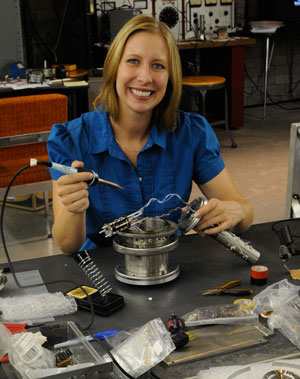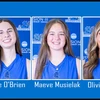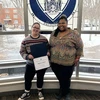|
“Her research provides an almost perfect training ground for students, in that it involves a lot of different fields of physics and various technologies – lasers, optics, vacuum techniques, high-voltage electronics, particle accelerators and detectors, and quantum theory.” -- Dr. Michael Grady, Physics Chair |
Dr. Erica L. Snow of the SUNY Fredonia Department of Physics has been awarded a $200,000 grant from the National Science Foundation (NSF) to support her research in studying basic properties of the hydrogen molecule.
The grant will fund equipment purchases and salaries for undergraduate research students for three years. Dr. Snow’s proposal was one of 24 selected for funding out of approximately 100 submitted to the Atomic and Molecular Division of the NSF for consideration.
According to Dr. Snow, the grant “recognizes the excellent potential of both the faculty and the undergraduate students’ ability to perform relevant and interesting research at a high level.”
Dean of the College of Arts and Sciences John Kijinski noted, “Dr. Snow’s NFS grant is great news for a number of reasons. Of course, the fact that it will contribute to an important field of knowledge is wonderful. But along with that, it will allow Fredonia students to engage in high-power, original research. This is a great example of how research endeavors on the part of faculty can lead to unique and rich educational opportunities for our students.”
Dr. Snow noted that precise measurements obtained in the research program will provide additional information to test the current theories and expand knowledge of the hydrogen molecule, one of the simplest systems and therefore an excellent test ground and springboard to larger and more complicated systems.
The study will test current quantum mechanical theories of molecules which reach into several areas of physics and chemistry. Dr. Snow added that hydrogen, the most abundant element in the universe, has a lot of relevance in astrophysical studies, and that it is important to have precise information obtained in ground based experiments in order to correctly analyze astrophysical data.
For the molecules in the research study, one of the electrons is in its ground state and best pictured as zipping around in somewhat of a figure eight form around the two protons. However, a second electron will be in a high-angular momentum Rydberg state, defined as a very highly excited energy state of an electron attached to an atom or molecule.
The measurements in the study involve finding just how much energy is needed to shift the highly excited nearly circular path of the outer electron to an even more excited state.
Dr. Snow noted that energy can be added (or removed) from an atom or molecule in a variety of ways. One way is by using laser light where the frequency, or color, of the light depends on its energy. Her research will use both a carbon dioxide (CO2) laser and microwave energy to cause transitions between excited states. The laser light is intersected with a beam of extremely fast moving hydrogen molecules, all of which must take place under high vacuum, where the atmosphere is pumped out so that the molecules do not collide with anything else.
Several transitions between excited states can be caused by using different frequencies of a CO2 laser and different intersection angles between the laser and the fast molecular beam. The different intersection angles take advantage of what is called the Doppler Effect.
Dr. Snow added a common example of this effect is when hearing a higher pitched sound from a fire truck siren that is approaching, compared to when it is stationary. Similarly, the beam of molecules experiences a higher frequency (or energy) when the laser is coming in such that they “collide” more head on than from the side or behind. A special detection system is used to decipher when a transition occurred.
Once a fine structure pattern is obtained through measurements, Dr. Snow noted, the information can tell quite a bit about how the parts making up the molecule interact with each other.
Department Chair Michael Grady noted, “Dr. Snow’s grant will allow her to perform sophisticated experiments which are truly cutting edge. Her research provides an almost perfect training ground for students, in that it involves a lot of different fields of physics and various technologies – lasers, optics, vacuum techniques, high-voltage electronics, particle accelerators and detectors, and quantum theory.”
Dr. Snow said that the scope of the funding goes beyond scientific research, providing opportunities for students and community members to be exposed and excited about physics research. Interested persons can contact Dr. Snow via e-mail at Erica.snow@fredonia.edu for more information about her research.




